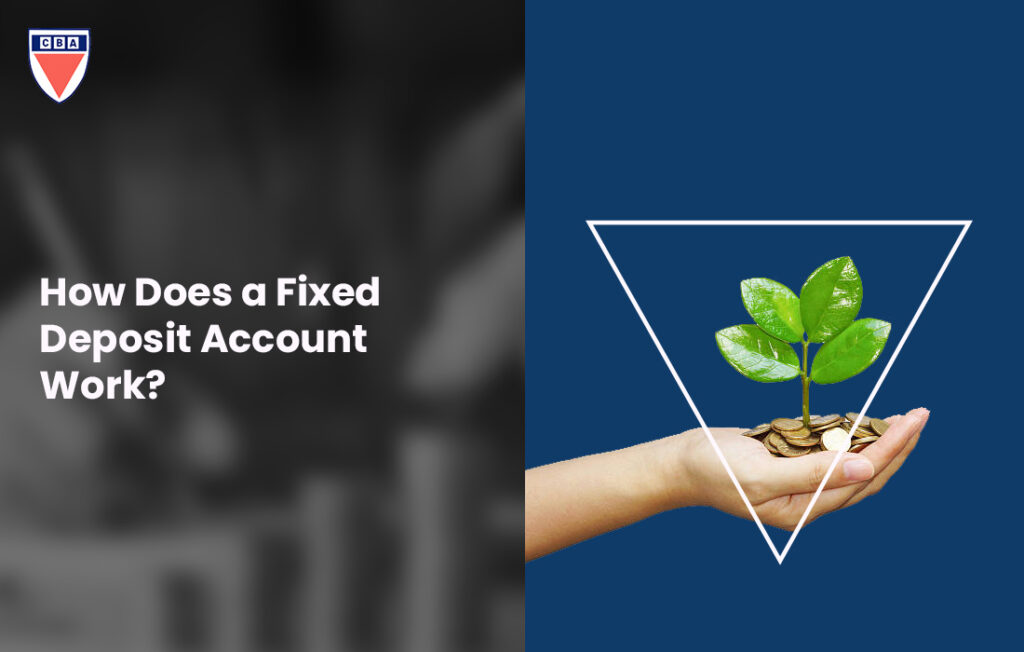A Fixed Deposit (FD) Account is a popular and well-established investment vehicle in personal finance. FDs are a safe way of progressively growing your money through a bank or financial institution that guarantees a return. In an FD account, you deposit a sum of cash with a bank or financial institution for a particular length of time at an agreed-upon interest rate. After the period has lapsed, you are paid back the amount of the deposit and the interest.
If you are thinking about doing a fixed deposit or trying to understand how it works, this guide will discuss everything regarding FD accounts: what they are, how they work, their advantages, important FD information, and more.
What is a Fixed Deposit Account?
A Fixed Deposit (FD) Account is a monetary instrument with banks and financial institutions that allows an individual to deposit a specified amount of money for a specified length of time, typically at a fixed interest rate. Deposited funds within an FD account must remain in the FD account for the agreed-upon length of time, which could be as short as a few days or as long as several years. With the money deposited, you will be earning interest; the interest must be compounded either periodically or at the end of the fixed period.
How Fixed Deposit Works?
Understanding Fixed Deposit:
FD accounts are typically one of the simplest types of investment products to use; Here’s generally how it works:
1. Deposit the Principal:
To open a Fixed Deposit account, you need to deposit a lump sum of money with a bank or other financial institution. The minimum deposit amount for an FD account will vary from bank to bank. Most financial institutions will consider a minimum deposit amount of ₹1,000 as standard; however, again, this may vary across financial institutions.
2. Choose a Tenure:
Tenures for an FD can range from a few weeks to a few years, so most likely, you already have a time in mind for the deposit. You can choose the tenure depending on your financial goals. Typical tenures can range from 7 days to 10 years. Typically, shorter tenures will have lower interest rates, and longer tenures will have higher returns.
3. Interest Rate:
Typically, the bank or financial institution will offer a fixed rate of interest on a Fixed Deposit that is higher than that on a regular savings account. The interest rate can be fixed or variable, depending on the type of FD. Interest rates may vary depending on current market conditions, the tenure of the FD, and the bank’s policies.
4. Interest Payout:
Priority one for your investment: You get to choose how you want your interest paid out. Banks will typically offer you three choices:
- Monthly: Interest paid monthly. This is the option for everyone who needs income from their investment on a monthly basis.
- Quarterly: Interest paid quarterly. This is the option for everyone who wants some income but can’t commit to a monthly interest payment.
- Cumulative Option: Interest is compounded on a periodic timetable and paid along with the principal at maturity. This process gives you the option of earning interest on your interest when interest is paid at maturity.
5. Maturity:
When the FD’s investment duration, the Fixed Deposit Account comes to an end. The investor is paid back the principal amount and interest. You can take your total to that date and either withdraw or reinvest in a new FD account.
6. Premature Withdrawal:
In the event of an emergency, you can select premature withdrawal of the FD. But it is up to every bank to charge a penalty for early withdrawal, meaning you reduce the interest rate earned on your investment. If you prefer the option and have made a couple of payments, there may be a fee associated with transferring the funds.
Fixed Deposit Account Definition:
A Fixed Deposit Account is an investment in which the account holder invests a particular amount of money for a specific period at a fixed interest rate. The amount active in the Fixed Deposit Account cannot be withdrawn by the account holder until the maturity date unless additional interest is paid. A Fixed Deposit Account can be described by its interest rate, specified duration, and guaranteed returns. The account holder will receive both the principal amount and interest after the maturity date.
What is a Fixed Account?
When people refer to a fixed account, they are likely referring to a Fixed Deposit Account. A fixed account is an investment account in which the money deposited is earmarked for an entire fixed period at a previously established interest rate. The term fixed account is often used interchangeably with fixed deposit; both terms define the same financial instrument as offered by banks and financial institutions.
Key Features of a Fixed Deposit Account:
A Fixed Deposit Account has multiple characteristics that make it a feasible investment choice:
a) Guaranteed Returns:
One of the main reasons people invest in FD accounts is for the guaranteed returns. Since it is a fixed interest rate, you know exactly how much you will make over the term of your investment. The returns you earn on an FD account are also unaffected by market fluctuations, which means you have low risk associated with your investment.
b) Low Risk:
Fixed deposits are considered a safe investment. There is very little risk because at the end of your tenure, your principal amount, plus interest, is returned to you. Even if your bank becomes insolvent, you are insured up to ₹5 lakh through the Deposit Insurance and Credit Guarantee Corporation (DICGC) scheme.
c) Greater Interest Rates:
Fixed Deposit accounts usually pay higher interest rates than savings accounts, so they are a good opportunity to be able to earn better returns on your savings.
d) Flexibility:
A Fixed Deposit (FD) account has flexibility in terms of the duration you can choose to keep your deposit. You can choose to have a short-term (1 month) or long-term deposit (10 years) and everything in between, based on your investment objectives. Furthermore, banks also have interest payout options—you can choose to have interest paid monthly or quarterly, or structure it at maturity.
e) Taxation:
The earnings (interest) on the Fixed Deposit Account will be taxed at a person’s applicable Income tax rates.H owever, banks offer what is known as Tax Saver Fixed Deposits, which have tax benefits under Section 80C of the Income Tax Act, you can claim up to ₹1.5 lakh deduction from your gross taxable income.
Types of Fixed Deposit Accounts:
1. Regular Fixed Deposit:
A Regular Fixed Deposit Account is the most common type of FD. You deposit the lump sum amount for a fixed term and at an interest rate agreed on a prior basis. The bank then pays you interest at either monthly, quarterly, or maturity.
2. Tax Saver Fixed Deposit:
A Tax Saver Fixed Deposit is a form of FD that allows an individual to put away money in a fixed deposit while the money is secured for a minimum period of 5 years and is used to claim a deduction of up to ₹1.5 lakh under Section 80C. This is ideal for anyone looking to save on tax and still earn interest.
3. Senior Citizens Fixed Deposit:
Banks offer senior citizens a higher rate of interest on Fixed Deposit Accounts (generally, an additional 0.25-0.75% on the FD rate). Therefore, this fixed deposit option is a good choice for retirees who want regular income from a secure interest income.
4. Reinvestment Fixed Deposit:
Under this fixed deposit, the interest is reinvested back into the fixed deposit, so the principal and interest will be repaid at maturity. This is great for individuals who do not need current income and prefer to compound interest over time.
5. Cumulative Fixed Deposit:
A Cumulative Fixed Deposit works off compound interest. The interest gets compounded quarterly or annually and refunded at maturity. A cumulative fixed deposit earns higher returns than a simple interest fixed deposit.
Benefits of a Fixed Deposit Account:
1. Protection of Capital:
Fixed deposits are capital-protected, meaning that the capital you invested is secure, and the interest is guaranteed. That is one of the primary reasons why investors prefer fixed deposits to investment vehicles that are riskier, like equities.
2. Stable Income:
Fixed deposits provide a consistent cash inflow from interest. Some investors depend on cash inflows to live on; for those individuals, the regular monthly or quarterly payment option becomes very helpful.
3. Ideal for Low-Risk Investors:
FDs are an ideal account for anyone who prefers earning money. There is no risk of losing your capital, and the interest earned on the account is already decided.
4. Facilitates Goal Planning:
Fixed deposits can help in planning things. Hardly anything in life becomes easier than investing the cash for your kids’ education, getting a decent house, or establishing a lump-sum amount for retirement. Fixed deposits provide certainty.
How to Choose a Fixed Deposit Account?
When selecting a Fixed Deposit Account, factors to consider include the following:
1. Interest Rates:
Check the interest rates offered by various banks and financial institutions. Interest rates determine the return you will receive on your investment, and a higher interest rate will generate higher returns.
2. Tenure:
Select a tenure that aligns with your financial goals. While a short-term FD can be flexible, it often does not attract competitive interest rates compared to long-term FDs.
3. Interest Payout Options:
Select an interest payout option that meets your preferences and income requirements. Monthly and quarterly payouts are by far the most useful payout options for users who wish to generate income. Payout options that are cumulative work best for people who wish to grow their capital account.
4. Penalties for Premature Withdrawal:
Consider the penalties associated with premature withdrawal. Some banks charge a penalty fee for early withdrawal of an FD prior to maturity, which may cut into some of your profits.
5. Tax Considerations:
Consider the tax implications of the FD interest. If you are seeking to create tax-saving opportunities, consider a “tax-saving FD.”
Conclusion
Using a Fixed Deposit Account is arguably one of the safest and most guaranteed methods of investment. Whether you are hoping to save money, earn income, or achieve a financial target, a Fixed Deposit will pay you a guaranteed return, without the potential risk of other forms of investment. By knowing how Fixed Deposits work and understanding where they fall, you can determine how to use all forms of investment to match your financial goals and can adapt your style of investment.
Overall, a Fixed Deposit is a good investment tool for people wanting a safe, predictable, and simple way to invest their money.






